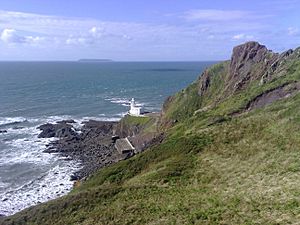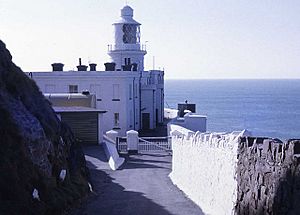Hartland Point Lighthouse facts for kids
 |
|
| Hartland Point lighthouse. Lundy Island can be seen on the horizon | |
|
|
|
| Location | Hartland Point Devon England United Kingdom |
|---|---|
| Coordinates | 51°01′19.4″N 04°31′32.6″W / 51.022056°N 4.525722°W |
| Year first constructed | 1874 (first) |
| Year first lit | 2012 (current) |
| Automated | 1984 |
| Deactivated | 2012 (first) |
| Construction | brick tower |
| Tower shape | cylindrical tower with balcony and lantern attached to a 2-storey keeper's house |
| Markings / pattern | white tower and lantern |
| Height | 18 m (59 ft) (first) 1.5 m (4.9 ft) (current) |
| Focal height | 37 m (121 ft) (first) 20.5 m (67 ft) (current) |
| Original lens | Bi-form 3rd order 500mm 6 panel rotating |
| Intensity | 635 candela |
| Range | 25 nmi (46 km) (first) 8 nmi (15 km) (current) |
| Characteristic | Fl (6) W15s. |
| Fog signal | blast every 60s. |
| Admiralty number | A5622 |
| NGA number | 6252 |
| ARLHS number | ENG 051 |
The Hartland Point Lighthouse is a special building located at Hartland Point in Devon, England. It's considered a Grade II listed building, which means it's historically important. This point marks the western edge of the Bristol Channel on the English side. Beyond it, the vast Atlantic Ocean stretches out.
Trinity House, the official group that manages lighthouses in England and Wales, operates this lighthouse. It stands proudly at the very tip of the peninsula.
Contents
History of Hartland Point Lighthouse
Building the Lighthouse
The lighthouse was designed by a famous engineer named Sir James Douglass. Construction started in November 1873. A builder from Wales, Mr. Yerward, did the work. He was supervised by Henry Norris, who had worked with Douglass before.
The tower is 18 metres (59 ft) (about 59 feet) tall. Its lamp shines from 37 metres (121 ft) (about 121 feet) above the average sea level. The lighthouse was officially opened on July 1, 1874. Lady Stucley of Hartland Abbey had the honor of lighting it for the very first time.
How the First Light Worked
The original light used a special lens called a first-order rotating catadioptric array. This fancy lens was designed by James Chance. It flashed in a unique pattern: two white flashes followed by one red flash, every thirty seconds.
To make the red flashes, some parts of the lens had ruby glass panels. These red panels were wider than the clear ones. This helped make sure the red light was still bright enough. The powerful light could be seen up to 25 miles (40 km) (about 40 kilometers) away from the coast.
Fog Signals and Keepers' Homes
At first, the lighthouse had a reed fog signal. It would sound once every two minutes. Later in the 1800s, this was replaced by a two-tone fog siren. Both of these early signals were powered by special engines. In 1911, a new reed horn was installed, and the old engines were replaced with oil engines. The fog signal came from a small building near the lighthouse.
The lighthouse was built with homes for four lighthouse keepers and their families. To protect the lighthouse from the sea, a 30 metres (98 ft) (about 98 feet) long sea wall was built in 1925. Large concrete structures nearby provided fresh water for the keepers.
Modernizing the Light and Automation
In 1927, the lighthouse was updated to use electricity. The old lens was replaced with a new, more advanced one. This new light flashed six times quickly in 7.5 seconds. It used two powerful electric lamps. If one lamp failed, an automatic system would switch to a backup lamp. At the same time, a new diaphone fog signal was installed, sounding three blasts every 75 seconds.
In January 1959, the lighthouse was connected to the main electricity supply. The old generator was kept for emergencies. Later, the diaphone fog signal was replaced with an electric horn.
The lighthouse became automated in 1984. This meant that human keepers were no longer needed there. The lighthouse was then controlled remotely from the Trinity House Operations Centre in Harwich, Essex. The homes where the keepers used to live were taken down. This made space for a Helipad to be built. A helipad was needed because the road to the lighthouse often had rock falls and landslips, making it hard for vehicles to get through. The fog signal was stopped in 2010.
Changes in 2012
Trinity House decided that a very powerful light was no longer needed at Hartland Point. A modern LED light beacon was placed in front of the old lighthouse. This new light is more energy-efficient and still helps sailors safely. Because of this, the original light was turned off in 2012.
Trinity House later put the lighthouse up for sale. It was advertised with a guide price of £500,000. The sale included the former lighthouse building, a three-bedroom house, storage areas, the helipad, and the access road. The entire property covered about 16 acres of cliff and coastline, offering amazing sea views.
See also
 In Spanish: Faro de Punta de Hartland para niños
In Spanish: Faro de Punta de Hartland para niños





